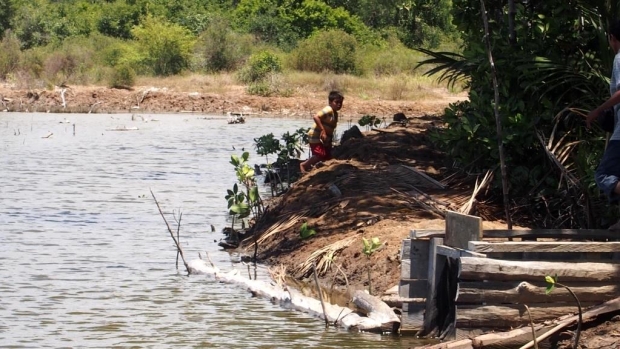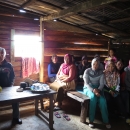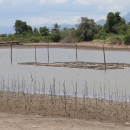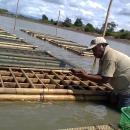Grants :: Small Grant Facilities :: The Development of Silvofishery Techniques, Mangrove Rehabilitation, and Women's Empowerment by Processing Non-Timber Plants in Mangrove Forest
The Development of Silvofishery Techniques, Mangrove Rehabilitation, and Women's Empowerment by Processing Non-Timber Plants in Mangrove Forest

A farm applying silvofishery method, Siduwonge village, Randangan District, Pohuwato Regency, Gorontalo © MFF IUCN, 2015
Objectives
To develop sylvo-fishery method, to rehabilitate mangrove ecosystem and to empower women’s group
Background
Limbula and Siduwonge are two bordering villages, which most of the areas located on the Tanjung Panjang Strict Nature Reserve (CATP). The reserve gazetted through the decree of Minister of Forestry, 1985. According to the spatial analysis, the reserve has 7,384 ha of mangrove areas, including the areas south to the reserve.
Generally, the mangrove areas in the CATP reserve, including both villages, have been disturbed resulted from conversion into fish ponds started during the early 1980s, and salt ponds at the back zone. The conversion into fish ponds are still observed, and mostly still not been operated yet. The development of fish ponds is requiring longer time, especially if these are operated without heavy equipment.
Salt ponds usually developed at the back zone which has sandy dry substrate. Naturally, the area dominated by Lumnitzera racemosa formation.
Based on the land use changes analysis using 2002 and 2011 high resolution satellite images, it can be determined that 90% of the 5,631 ha mangrove areas of the reserve in 2002 have been lost in 2011. The remaining intact forest is only available along river bank, no more than 50 m width.
Target beneficiaries
20 members of the women's group and members of the fish farmer association.
Outputs
- 20 members of 2 women’s groups received training on mud crab rearing. 1,060 crab juveniles were deployed on 20 floating cages;
- 40,000 mangrove seedlings were planted with 62% growth rate to rehabilitate 5 ha areas along riverbanks and pond dykes;
- 20 Ha of sylvo-fishery fishpond was developed as a model where 150,000 shrimp fingerlings and 120,000 milkfish juveniles were deployed, and 7,000 mangrove seedlings were planted;
- 50 community members actively engaged and participated on village meetings and mangrove ecosystem management supported by local government.
Accomplishments and challenges
- A total of 50% of 40,000 Ceriops sp. seedlings were survived in the nurseries. The additional 3,100 seedlings (2,500 Ceriops sp, 500 Rhizopora sp, and 100 Bruguiera) had been planted in the nurseries. All seedlings in the nursery had been planted in the restoration areas. The remaining seedlings (55,000 seedlings) were planted directly in the restoration areas. The high mortality of the seedlings were mostly resulted from the long dry season in the area, as marked by the continuous operation of salt-making in the fish-pond areas. Total rehabilitation areas: 5 ha;
- The following activities have been implemented aimed on the improvement of community’s livelihood:
- Provision of crab fattening facilities (boxed crab cages) to women group members. As recommendation of the trainer, a total of twenty 2 x 1 meter crab cages had been built and provided to the women's groups;
- A total of 400 juvenile crabs had been distributed to community groups to be cultured on the cages;
- Crab capture nets had been provided for each group;
- Pilot silvofishery model has been implemented. An agreement has been made between Japesda and 2 fish-pond owners, witnessed by Head of Village, on the provision of initial capital for the development of sustainable silvofishery model. Under this agreement, Japesda (with support from MFF) provided support of 120,000 milk fish and 100,000 shrimp schooling to the tambak owners. As part of the agreement, the tambak owners agreed to plant and maintain a total of 5,000 seedlings in their pond’s dyke (done on the end of December 2014) and put a sign board at each pond. Following the next first harvest of the milk fish and shrimp, the pond owners agreed to return the no-interest initial capital to Japesda, which would then be used to fund the additional and/or continuation of women group’s economic activities. Under the previous proposal, it was proposed to provide very small numbers of milk fish and 250,000 vename shrimp.
- Fair engagement of both women and man was very much visible in both planting as well as livelihood activities;
- Community groups actively engaged on the programme, including some self-initiated activities. The increased understanding of the community group members on the objective of the programme and active engagement of the group members to provide input were resulted from fully support of village government, especially the leadership of (Female) Head of Village
- In contrast, poor performance of the Grantee that still needed to improve their understanding and initiative to align the community eagerness into the accomplishment of MFF supported objectives.
Contributions to cross-cutting themes
- Climate change and disaster risk reduction
40,000 mangrove seedlings were planted to rehabilitate 5 ha areas along riverbanks and pond dykes.
- Gender equality
20 members of 2 women’s groups received training on mud crab rearing. Fair engagement of both women and man was very much visible in both planting as well as livelihood activities.
Lessons Learned
- A Field facilitator who provides constant technical assistance might be needed to optimize activities conducted by the local community groups and supports given by the communities;
- Capacity of the groups should be improved, e.g. providing micro-business management training.
Country
Location
Siduwonge village, Randangan District, Pohuwato Regency, Gorontalo
Topic
Duration
6th May 2014 to 5th May 2015
MFF Grant Amount
IDR 195,425,000
Implementing Partner
JAPESDA Gorontalo
Jl. Durian No. 19 Kel. Huangobotu Kec. Dungingi, Kota Gorontalo, 96115
Contact person: Mr Ahmad Bahsoan, Project Manager
Mobile: +6281340567916
Email address: japesda.gorontalo@yahoo.com/
matbahsoan@yahoo.com


